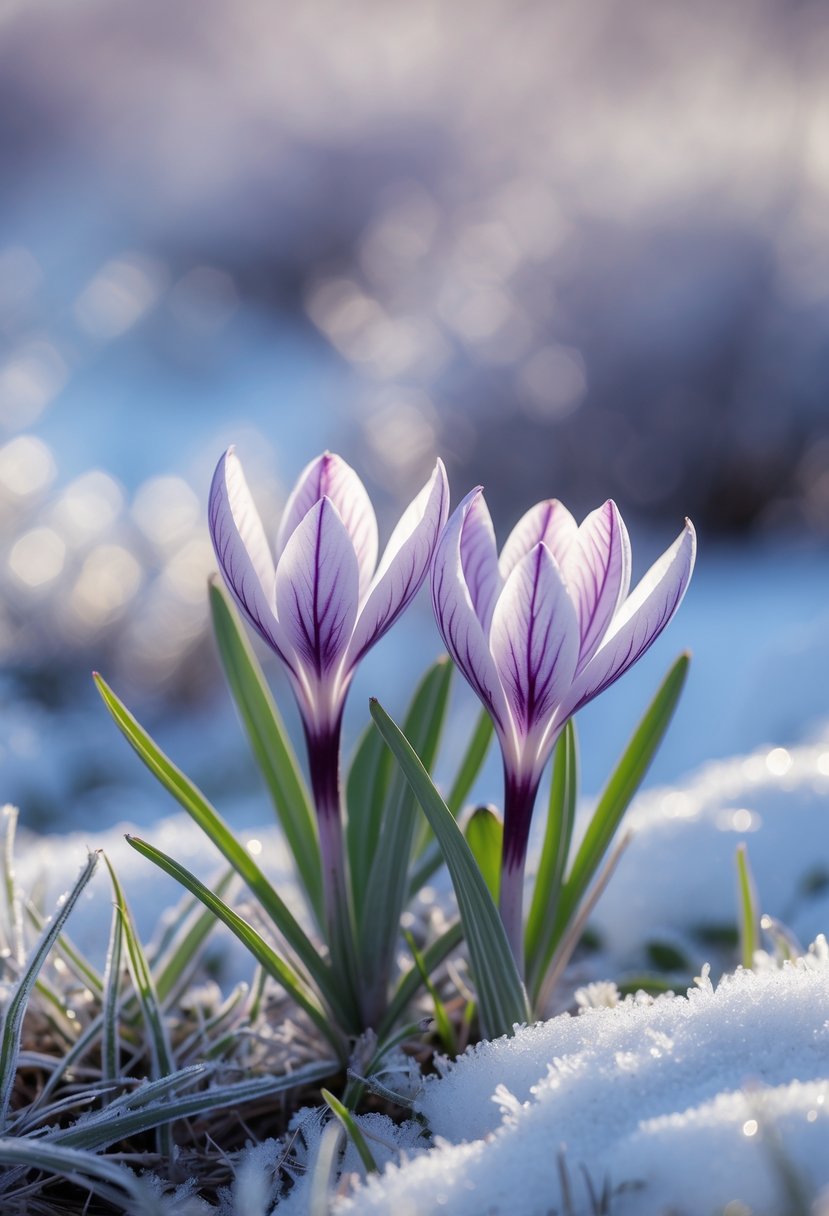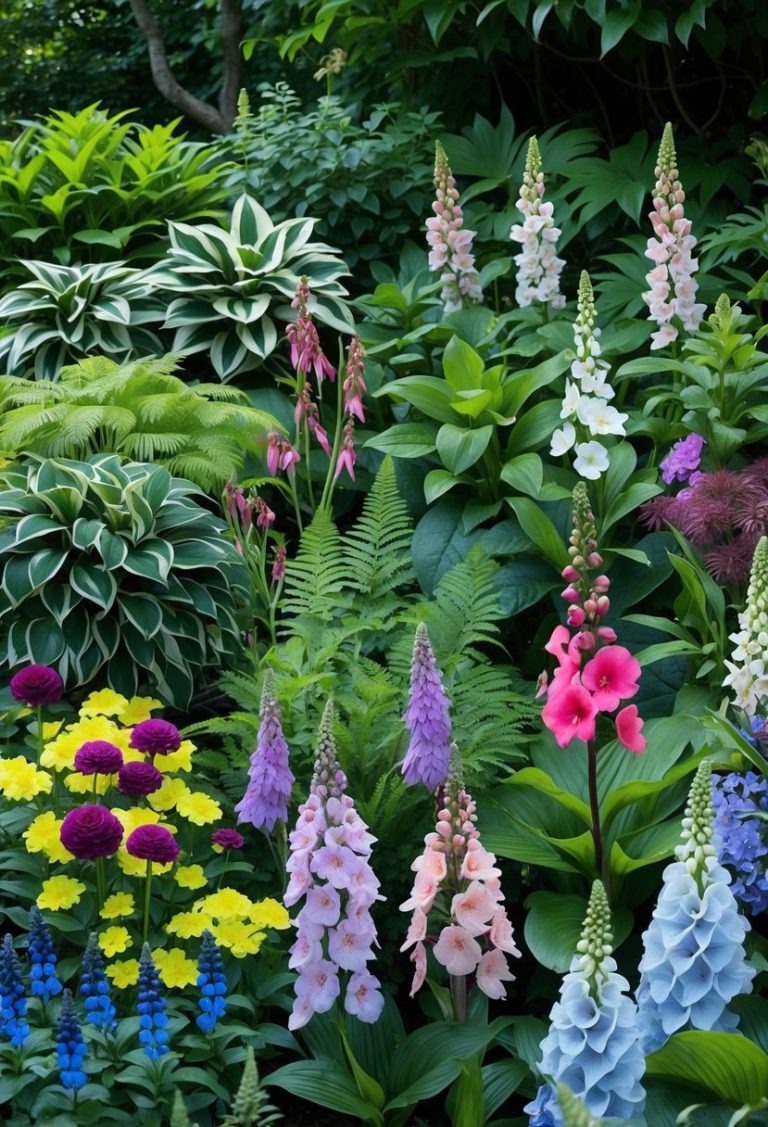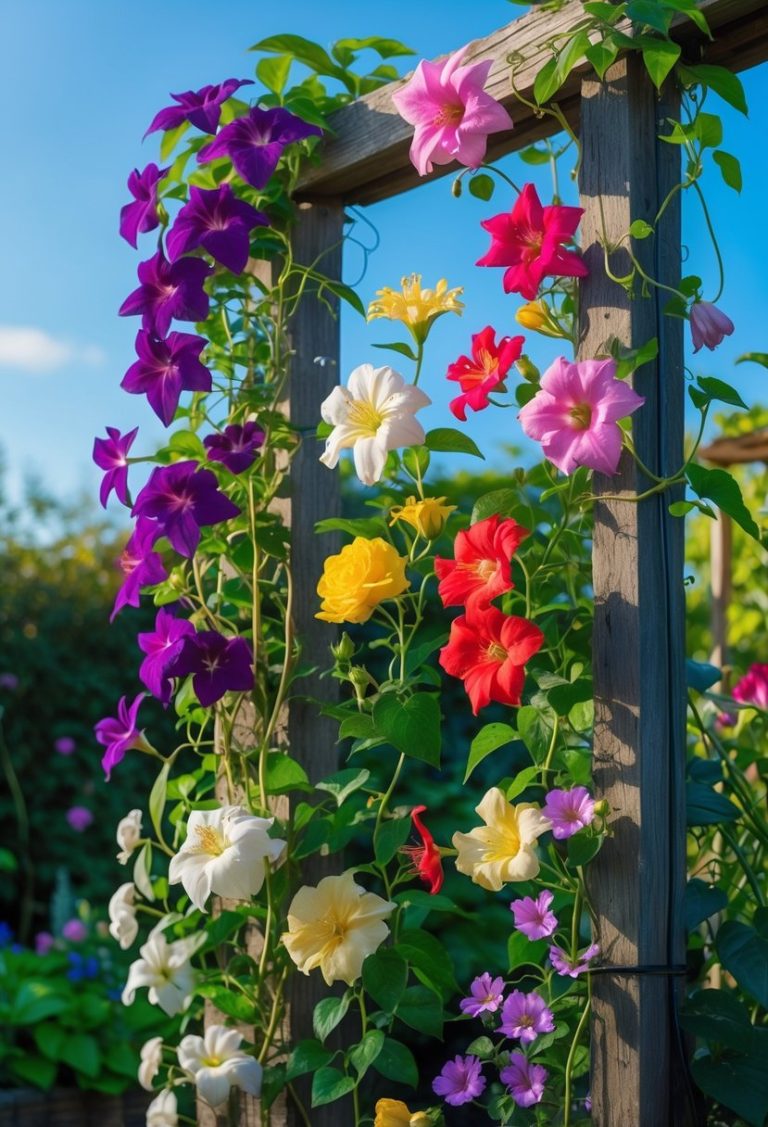22 Beautiful Winter Flowers That Survive and Bloom in the Cold For Stunning Cold-Season Gardens
Winter can make your garden look dull and lifeless, but it doesn’t have to. Many flowers can survive cold weather and continue to bloom even when temperatures drop.

You can keep your garden colorful and vibrant during winter by choosing flowers that are built to thrive in the cold. These plants add beauty and life to your outdoor space when most other flowers are resting.
1) Hellebores (Lenten Rose)

You can count on hellebores to bloom in late winter or early spring when most plants are still asleep. These perennials, also called Lenten Roses, thrive in shady spots with partial sun.
Their flowers come in many colors, from soft pinks to deep burgundy. With evergreen leaves, they add color and life to your garden all year.
Hellebores need little care and resist deer and pests. They are a good choice if you want winter interest without much work.
2) Snowdrops (Galanthus)

You will notice snowdrops early in late winter or early spring. Their small, white flowers have a drooping, bell shape that looks like drops of snow.
These hardy plants can grow through snow and cold, signaling that spring is near. Snowdrops do well when planted in groups along paths or in garden borders.
If you give them well-drained soil and partial shade, your snowdrops will bloom year after year. They are low-maintenance and deer resistant, making them easy to grow in cold weather.
3) Winter Jasmine (Jasminum nudiflorum)

You will notice winter jasmine blooming early, often in late winter when few other plants do. Its bright yellow flowers appear on leafless stems, bringing color to cold gardens.
This shrub grows well in full sun or partial shade. It is hardy and can handle low temperatures. Winter jasmine is easy to care for and spreads quickly.
4) Witch Hazel (Hamamelis)

Witch hazel is a hardy shrub that blooms in late winter when few other plants do. Its unique, ribbon-like flowers appear on bare branches, adding color and fragrance to your garden.
You can find several varieties, including native species with yellow or red flowers. Witch hazel grows well in sun or partial shade and needs little care once established. It’s a good choice to brighten cold months without extra effort.
5) Camellias

You can count on camellias for color during cold months. These evergreen shrubs bloom from fall to early spring with flowers in shades of white, pink, and red.
Camellias handle winter well if you protect them from frost. Their glossy leaves and beautiful blooms make your garden look alive when most plants are dormant.
Choosing cold-hardy varieties helps your camellias survive in colder climates. With proper care, they add reliable beauty through the winter season.
6) Heather (Calluna vulgaris)

You can grow Heather, also called Calluna vulgaris, in cold climates. It is a small shrub that stays low to the ground.
Heather blooms from mid-summer and can keep flowers into winter, sometimes lasting until February.
This plant prefers full sun and acidic soil. When planted well, it requires little care. Its flowers add color to your winter garden.
7) Cyclamen Coum

You can grow Cyclamen coum as a groundcover in cold winters. It blooms in late winter or early spring, sometimes even through snow.
The flowers come in pink, magenta, or white colors. Its heart-shaped leaves often have silver patterns, adding interest even when the plant is not flowering.
Cyclamen coum is hardy and easy to care for. It brightens gray winter days with delicate blooms and can survive frost and cold temperatures.
8) Pansies (Viola tricolor)

You can plant pansies in fall to enjoy color through winter. They tolerate cold temperatures down to 25°F and often bloom even in snow.
Pansies have bright, multicolored flowers that bring life to dull winter days. They are hardy and can survive frost and light freezes.
If you want early spring blooms, winter pansies are a good choice. They are easy to care for and add cheer to your garden during cold months.
9) Winter Aconite (Eranthis hyemalis)

Winter Aconite blooms early, often before crocuses. You will see small, bright yellow flowers that appear in late winter or early spring.
These flowers grow from tubers and have green, lobed leaves that come after the blooms. Winter Aconite does best in full sun or partial shade with well-drained soil.
It is hardy and adds color when most plants are still asleep. You can plant the tubers in fall for blooms in the cold months.
10) Helleborus Niger (Christmas Rose)

You can grow Helleborus niger, also called Christmas Rose, for winter blooms. Its white flowers appear in cold weather, often around Christmas in mild areas or late winter in colder zones.
This plant is an evergreen perennial. Its flowers face outward, making them easy to see even under snow.
You should plant it in well-drained soil with some shade. It adds beauty when most other plants rest.
11) Iris Reticulata

You can grow Iris Reticulata in cold climates. This small iris blooms in late winter or early spring, bringing early color to your garden.
Plant its bulbs in well-drained soil with full sun. Space them about 3 inches apart and 3 inches deep for best results.
The flowers are usually blue or purple, with some varieties showing gold or white markings. They work well in rock gardens or containers.
12) Mahonia

Mahonia is a hardy evergreen shrub with glossy, spiky leaves that add texture to your garden year-round. It produces bright yellow flowers in winter, which attract pollinators when most plants are dormant.
You can plant Mahonia in full sun or partial shade. It prefers a sheltered spot to protect it from strong cold winds. Its leaves may turn bronze or purple in colder weather, adding extra color.
13) Heather

Heather is a low-growing evergreen shrub that blooms in winter. You will find it in shades of purple, pink, and white.
It grows well in cold zones, often surviving temperatures that drop below freezing. Heather adds color to your garden when most plants are dormant.
You can choose varieties like Erica carnea, which are hardy and bloom even in harsh winter conditions. It needs well-drained soil and some sunlight to thrive.
14) Winter Heath (Erica carnea)

Winter Heath is a low-growing evergreen shrub that adds color to your garden in late winter. You’ll see small, vibrant flowers in pink, purple, or white even when it’s cold.
This plant is hardy and thrives in well-drained soil with plenty of sunlight. Its needle-like leaves keep your garden interesting when it’s not blooming. Winter Heath works well in borders, rock gardens, or containers.
15) Pasque Flower (Pulsatilla)

You can add the Pasque Flower to your garden for early spring color. It blooms with bell-shaped purple flowers that appear even as snow melts.
This plant grows well in well-drained, alkaline soil. Its soft, fern-like leaves add interest before and after blooming.
Pasque Flowers stay low to the ground, making them perfect near walkways or garden edges. They also attract bees to your garden.
16) Daphne

You can add Daphne to your winter garden for both beauty and scent. It blooms early, often when most plants are still asleep.
Its flowers are small but fragrant, filling your space with a pleasant aroma.
To keep your Daphne healthy, prune lightly and avoid cutting into the main stem. This helps ensure it blooms well year after year.
17) Glory of the Snow (Chionodoxa)

You can plant Glory of the Snow bulbs in the fall, after the first frost but before the ground freezes. These flowers bloom very early in spring, often while snow is still on the ground.
The flowers have star-shaped petals in blue, white, or pink. They grow from small bulbs and have narrow, grass-like leaves.
Glory of the Snow is hardy and does well in cold climates. It adds early color to your garden when most plants are still dormant.
18) Crocus tommasinianus

You can count on Crocus tommasinianus to bloom early, often while snow still covers the ground. Its pale purple flowers appear in late winter or early spring, bringing color when most plants are still dormant.
This plant grows well in well-drained soil. You should plant the bulbs about 3 to 4 inches deep and space them the same distance apart for best results.
Crocus tommasinianus is easy to care for and adapts well to woodland or garden settings. Its early blooms signal the coming of spring in your yard.
19) Viburnum Tinus

You can count on Viburnum Tinus to brighten your garden during winter. This evergreen shrub has clusters of pink buds that open to white flowers, offering color when many plants are dormant.
It is hardy and low maintenance, making it a good choice for borders or hedges. The leaves stay green all year, giving your garden constant greenery even in cold weather.
20) Kerria Japonica

You can add Kerria Japonica to your garden for bright green stems that stand out in winter. This shrub keeps its vibrant green color even when leaves fall.
In spring, it blooms bright yellow flowers that look like small roses. The flowers last for several weeks, adding color after early spring plants have faded.
Kerria does best in part sun or shade. It grows well in many soils and handles cold winters in most areas.
21) Winterberry (Ilex verticillata)

You can add bright color to your garden in fall and winter with Winterberry. This deciduous holly loses its leaves, revealing clusters of red berries on female plants.
Winterberry grows well in wet soils and can reach 5 to 8 feet tall. You should plant both male and female plants for berries to appear.
Prune in late winter or early spring to keep its shape, but avoid heavy pruning to maintain fruit production. It also attracts birds during winter.
22) Skimmia Japonica

You will find Skimmia Japonica a slow-growing evergreen shrub that thrives in shade. It has glossy leaves and white, fragrant flowers that bloom in spring.
In fall, female plants produce bright red berries that last through winter. These berries add color to your garden when most plants are bare.
Skimmia does best in cooler climates and requires regular watering during dry spells, especially if grown in pots. It grows well in USDA zones 6 to 8.
How Winter Flowers Thrive in Cold Conditions

Winter flowers survive by using special features that protect them from frost and snow. They also take advantage of light and temperature changes to grow and bloom during cold months.
Adaptations for Frost and Snow
Many winter flowers have thick, waxy leaves or hairy coatings that stop water loss and shield them from frost damage. Some have deep root systems to access water under frozen soil.
Certain plants, like evergreen perennials, keep their leaves all year and protect themselves by producing antifreeze-like chemicals in their cells. This lowers the freezing point of their fluids and prevents ice from forming inside their tissues.
You might notice these flowers grow low to the ground, where snow acts as insulation. Snow can keep temperatures around the plant more stable, preventing sharp freezes that cause harm.
The Role of Light and Temperature
Winter flowers are built to work with shorter days and colder temperatures. They often start blooming faster than spring flowers once they sense a slight rise in temperature or more light.
Some species use the little daylight they get more efficiently for photosynthesis, letting them make energy even in weak winter sun.
Cold temperatures slow down pests and diseases, giving your flowers a better chance to thrive. In fact, many winter plants need cold triggers to bloom properly, meaning the chill is part of how they stay healthy and flower.
Essential Winter Flower Care Tips

You need to focus on keeping the soil healthy and watering correctly during winter. Also, protecting your plants from harsh winds and freezing temperatures is necessary to keep them alive and blooming.
Watering and Soil Maintenance
Winter flowers still need water, but not as much as in warmer months. Check the soil moisture regularly by touching it. Water only when the top inch feels dry.
Use well-draining soil to prevent water from sitting around the roots, which can cause rot. Adding organic matter like compost helps keep the soil loose and feeds your plants.
Avoid watering in the late afternoon. Early morning watering allows the soil to absorb moisture before temperatures drop at night.
Mulching around the base of your plants helps keep the soil temperature steady and reduces water loss. Use straw, shredded leaves, or bark chips for this.
Protection from Extreme Weather
Cold winds and frost can damage your winter flowers quickly. You can protect them by placing windbreaks nearby, such as fences or shrubs.
If frost is forecast, cover your plants with frost cloths, old bedsheets, or burlap. Make sure the covers don’t touch the plants directly to avoid damage.
Bring potted winter flowers indoors or into a sheltered spot when temperatures drop below freezing. If that’s not possible, group pots close together to share warmth.
Avoid pruning in late fall or winter because it can expose plants to stress and cold damage. Instead, prune in early spring after the risk of frost passes.





